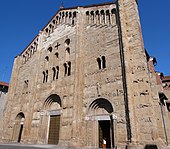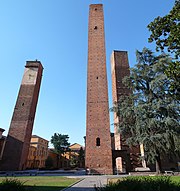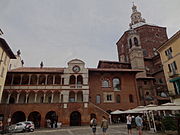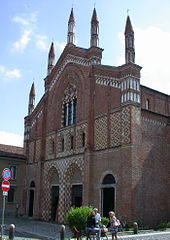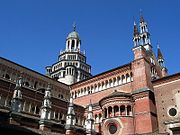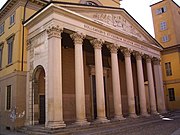Pavia
| Pavia | ||
|---|---|---|

|
|
|
| Country | Italy | |
| region | Lombardy | |
| province | Pavia (PV) | |
| Local name | Pavia | |
| Coordinates | 45 ° 11 ' N , 9 ° 9' E | |
| height | 77 m slm | |
| surface | 62 km² | |
| Residents | 73,334 (Dec. 31, 2019) | |
| Population density | 1,183 inhabitants / km² | |
| Post Code | 27100 | |
| prefix | 0382 | |
| ISTAT number | 018110 | |
| Popular name | Pavesi | |
| Patron saint | San Siro di Pavia | |
| Website | Pavia | |
Pavia [ paˈvia ] ( ) is a town with 73,334 inhabitants (as of December 31, 2019) in southwestern Lombardy in northern Italy on the Ticino River , about 35 kilometers south of Milan .
Pavia is the capital of the province of the same name , known for its agricultural products such as wines , rice , cereals and dairy products . Several industrial areas are located in the suburbs of Pavia. The city is home to one of the oldest universities in Europe, the University of Pavia . The place has been the seat of a diocese since the 1st century .
history
The city of Ticinum Papiae was already a large settlement in pre-Roman times and was later a fortified garrison in the Roman Empire . Under Emperor Aurelian , the largest Roman mint was located here under the direction of Gaius Valarius Sabinus .
Eventually the garrison was converted into a citadel and was the last bulwark of the Ostrogoths , who had conquered Italy at the end of the 5th century, against the Eastern Romans . After the conquest by the Longobards , who invaded Italy in 568 (Pavia fell after a three-year siege), Pavia became the capital of the Longobard Empire . In the course of the Lombard campaign from 773 to 774, the city was captured by Charlemagne after nine months of siege . In 1004 Heinrich II was elected and crowned King of Italy here. In the city there was a palace built by Theodoric , which Otto III. was magnificently decorated. The residents destroyed it after the death of Henry II in 1024, which led to a dispute with Konrad II , who claimed it as his property. Until the late Middle Ages , Pavia, now part of the Holy Roman Empire , retained great symbolic importance.
In the following centuries Pavia was one of the most important cities in Italy. In 1359, after a long siege, it was conquered by the Visconti family , rulers of Milan, and became a center of northern Italian art and science; In 1361 the first chair was established at the university. Students from the Christian countries of Europe flocked to northern Italy.
During the wars for Italy , from October 28, 1524, the city was besieged by a French army headed by King Francis I for several months . The defeat and capture of the King of France in the Battle of Pavia in February 1525 is one of the most important events of the European early modern period. It preceded the war of 1526/27, which showed the Italians defeated Charles V and led to a Spanish occupation that lasted until 1713 . Pavia was ruled by Austrian potentates until 1796, when it finally fell into the hands of the French army under Napoleon Bonaparte .
In 1815 the Austrian administration was restored until the second Italian War of Independence followed in 1859 and the unification of Italy the following year . The Pavia County existed from 1859 to 1927 . The old German name for the city comes from this time: Pawei .
In 1894, fifteen-year-old Albert Einstein lived with his family in Via Ugo Foscolo, 11 (Cornazzani house) in Pavia for about a year .
The writer Ada Negri , who comes from nearby Lodi , immortalized her beloved "Pavia, [brick] red, city of my peace" in the poem I giardini nascosti (The Hidden Gardens) published in 1936 .
Attractions
Of the architectural monuments of Pavia are several Romanesque and all the Gothic brick buildings, as well as the the Renaissance part of the cathedral.
Romanesque buildings
The two large Romanesque basilicas, erected at the same time in the first third and first half of the 12th century, are at the beginning of the Lombard Romanesque .
San Michele Maggiore
The Basilica of San Michele Maggiore is mainly built from a very sensitive sandstone, in contrast to most of the Romanesque and Gothic churches in the region, which are mainly brick. In its predecessor church, built during the Longobard period, Charlemagne was elected king in 774, replacing Desiderius as the last Longobard king. The building was destroyed by fire in 1004 during an uprising against the king's election and coronation of Henry II . The lower part of the bell tower still comes from her. Work on the current building began around 1100 and was completed in 1155.
San Pietro in Ciel d'Oro
The mostly brick- built Basilica minor San Pietro in Ciel d'Oro ('Saint Peter in the Golden Sky') is built over the grave of the philosopher Severinus Boëthius , who was executed by Theodoric the Great , and also contains the remains of the church father Augustine of Hippo .
Torre Civica
The Torre Civica, the city tower, was built in the 11th century. In 1583–1585 the architect Pellegrino Tibaldi put a bell storey on it. The bells of the cathedral, which did not have its own campanile , were hung here . On March 17, 1989 the tower collapsed, four people were killed.
Broletto
Erected in the 12th century as a bishop's palace, the Broletto later served as the Palazzo Comunale (town hall). In the 20th century, the fascists had their local headquarters in the building for a time.
Gender towers
In the 12th century, around fifty family towers were built in Pavia , three of which are still standing as free-standing towers. Remains of several other towers are built into houses today.
Gothic buildings
Visconteo Castle
The Castello Visconteo was built in 1360 by Galeazzo II Visconti . Today the city museum is housed in the castle. The park surrounding the castle once extended over ten kilometers to the Certosa di Pavia. Parts of it are still preserved today under the name Parco della Vernavola .
Santa Maria del Carmine
Built from 1371 to 1461, which is considered Carmelite church of Santa Maria del Carmine as the most important testimony of the Lombard Gothic .
San Francesco d'Assisi
The Franciscan Church, consecrated to its founder, is the city's second large Gothic brick church.
Certosa di Pavia
The Charterhouse of Pavia is an impressive monastery complex eight kilometers north of Pavia. In the core of the Gothic style, it also has elements from the Renaissance and Baroque periods. The complex was donated by Gian Galeazzo Visconti and construction began in 1396. Up until the 18th century it was expanded and redesigned several times. Today the monastery is managed by Cistercian monks and can be visited daily (except Mondays).
Ponte Coperto
The historic center of the city is north of the Ticino River , directly opposite is the Borgo Ticino district, which was originally outside the city fortifications. Both sides were connected by the Ponte Coperto , built between 1351 and 1354 . This Gothic bridge was destroyed during the Second World War. Today's bridge is a reconstruction from the 1950s and stands a few meters east of the original location. Most of the remains of the old bridge are only visible at low tide.
Renaissance and later
Pavia Cathedral
Pavia's Cathedral is an imposing structure with a plan in the shape of a Greek cross. Construction of the cathedral began as early as 1488, but it remained unfinished until 1898. This year the facade and the dome were completed according to original plans by Giovanni Antonio Amadeo . With a height of 97 meters, a weight of approx. 20,000 tons and a number of 34 windows, the octagonal dome is the third largest dome in Italy, only surpassed by St. Peter's Basilica in Rome and Santa Maria del Fiore in Florence .
Palazzo Centrale of the University
Construction phases 1534, 1661–1671, 1783, lastly in 1845–1850 the new Aula Magna with a classical portico.
traffic
Pavia has the motorways A53 and A54 two urban bypasses that to the motorway A7 ( Milan - Genoa are connected). The use of the two bypasses is free of charge .
The Pavia railway station is the main station of Pavia.
Town twinning
Pavia maintains city partnerships with
-
 Besançon in the Bourgogne-Franche-Comté region , France
Besançon in the Bourgogne-Franche-Comté region , France -
 Vilnius in Lithuania
Vilnius in Lithuania
-
 Hildesheim in Lower Saxony , Germany
Hildesheim in Lower Saxony , Germany -
 Ayamé in Ivory Coast
Ayamé in Ivory Coast
-
 Bethlehem in Palestine
Bethlehem in Palestine
-
 Hersbruck in Bavaria , Germany
Hersbruck in Bavaria , Germany
sons and daughters of the town
- Epiphanius of Pavia (439–496), bishop and statesman
- Sibyllina Biscossi (1287-1367), Blessed, Keklusin
- Opicinus de Canistris (1296 - approx. 1353), cleric at the Curia in Avignon, famous for the moralizing maps he created
- Gian Galeazzo Visconti (1351–1402), regent in Milan
- Agostino Mainardi (1482–1563), monk, teacher, rector and prior in the Augustinian order in Pavia, reformer of Chiavenna
- Gerolamo Cardano (1501–1576), doctor and mathematician
- Francesco Corbetta (1615–1681), guitarist and composer
- Alessandro Rolla (1757–1841), violin player and composer
- Gaetano Fraschini (1817–1887), opera singer (tenor)
- Luigi Cremona (1830–1903), mathematician, structural engineer and politician
- Felice Casorati (1835–1890), mathematician
- Achille Bizzoni (1841–1903), journalist, translator and writer
- Edoardo Bassini (1844-1924), surgeon
- Ambrogio Robecchi (1870–1963), racing cyclist
- Enrica Malcovati (1894–1990), classical philologist
- Carla Marangoni (1915-2018), gymnast
- Drupi (* 1947), singer (pop and rock)
- Maurizio Giammarco (* 1952), jazz saxophonist, composer and arranger
- Adriano Aguzzi (* 1960), Italian-Swiss doctor and university lecturer
- Andrea Migliavacca (* 1967), Catholic clergyman, Bishop of San Miniato
- Ada Rovatti (* 1976), jazz musician (saxophone)
Individual evidence
- ↑ Statistiche demografiche ISTAT. Monthly population statistics of the Istituto Nazionale di Statistica , as of December 31 of 2019.
- ^ Johannes Laudage , Die Salier - The first German royal house , CH Beck, 3rd edition, Munich 2011, ISBN 978-3-406-53597-0 , p. 17.
- ↑ Wilfried Hartmann (Ed.): German history in sources and presentation, vol. 1. Early and Hohes Mittelalter 750-1250 , Reclam, Stuttgart 1995, ISBN 978-3-15-017001-4 , pp. 236-237.
- ↑ Fabio Romanoni: "Come i Visconti asediaro Pavia". Assedi e operazioni militari intorno a Pavia dal 1356 al 1359, in "Reti Medievali- Rivista", VIII. 2007 ( academia.edu [accessed October 7, 2019]).
- ^ Ferdinand Gregorovius: History of the city of Rome in the Middle Ages: from V to XVI. Century , Volume 2, ISBN 978-3-406-07107-2 , p. 559. ( Preview in Google Book Search, new edition 2013, accessed on February 15, 2017)
- ^ Ada Negri: I giardini nascosti. In: Il dono (The Gift), Mondadori, Milan 1936, p. 56 f.
- ^ Photo of the memorial plaque for Ada Negri at the Boerchio family house in Corso Giuseppe Garibaldi 67 and the poem I giardini nascosti (here titled "Pavia") at magicamente.net.
- ↑ La tomba di sant'Agostino - Pavia , Official Website
- ↑ Torri medievali (The Medieval Towers) on Pavia Turismo , the official tourism website of the Municipality of Pavia, accessed on November 1, 2019.
- ↑ Pavia e le sue antiche torri (Pavia and its ancient towers) on visitapavia.it, accessed on November 1, 2019.
- ↑ Gemellaggi della Regione Lombardia (PDF; 9.88 MB)
Web links
← Previous location: Gropello Cairoli 18.1 km | Pavia | Next town: Belgioioso 17.3 km →
![]() Canterbury |
Dover |
Calais |
Wissant |
Guînes |
Licques |
Wisques |
Thérouanne |
Auchy-au-Bois |
Bruay-la-Buissière |
Arras |
Bapaume |
Peronne |
Doingt |
Seraucourt-le-Grand |
Tergnier |
Laon |
Bouconville-Vauclair |
Corbeny |
Hermonville |
Reims |
Trépail |
Châlons-en-Champagne |
Cool |
Brienne-le-Château |
Bar-sur-Aube |
Châteauvillain |
Blessonville |
Langres |
Humes-Jorquenay |
Coublanc |
Grenant |
Dampierre-sur-Salon |
Savoyeux |
Seveux |
Gy |
Cussey-sur-l'Ognon |
Besançon |
Étalans |
Chasnans |
Nods |
Ouhans |
Pontarlier |
Yverdon-les-Bains |
Orbe |
Lausanne |
Cully |
Vevey |
Montreux |
Villeneuve |
Aigle |
Saint-Maurice |
Martigny |
Orsières |
Bourg-Saint-Pierre |
Great St. Bernhard |
Saint-Rhémy-en-Bosses |
Saint-Oyen |
Étroubles |
Gignod |
Aosta |
Saint-Christophe |
Quart |
Nut |
Verrayes |
Chambave |
Saint-Denis |
Châtillon |
Saint-Vincent |
Montjovet |
Issogne |
Verrès |
Arnad |
Hône |
Bard |
Donnas |
Pont-Saint-Martin |
Carema |
Settimo Vittone |
Borgofranco d'Ivrea |
Montalto Dora |
Ivrea |
Cascinette d'Ivrea |
Burolo |
Bollengo |
Palazzo Canavese |
Piverone |
Azeglio |
Viverone |
Roppolo |
Cavaglià |
Santhià |
San Germano Vercellese |
Olcenengo |
Salasco |
Sali Vercellese |
Vercelli |
Palestro |
Robbio |
Nicorvo |
Castelnovetto |
Albonese |
Mortara |
Cergnago |
Tromello |
Garlasco |
Gropello Cairoli |
Villanova d'Ardenghi |
Zerbolò |
Carbonara al Ticino |
Pavia |
Valle Salimbene |
Linarolo |
Belgioioso |
Torre de 'Negri |
Costa de 'Nobili |
Santa Cristina e Bissone |
Miradolo Terme |
Chignolo Po |
San Colombano al Lambro |
Orio Litta |
Senna Lodigiana |
Calendasco |
Rottofreno |
Piacenza |
Podenzano |
San Giorgio Piacentino |
Pontenure |
Carpaneto Piacentino |
Cadeo |
Fiorenzuola d'Arda |
Chiaravalle della Colomba |
Alseno |
Busseto |
Fidenza |
Costamezzana |
Noceto |
Medesano |
Fornovo di Taro |
Terenzo |
Berceto |
Pontremoli |
Filattiera |
Villafranca in Lunigiana |
Bagnone |
Licciana Nardi |
Aulla |
Santo Stefano di Magra |
Sarzana |
Castelnuovo Magra |
Ortonovo |
Luni |
Fosdinovo |
Carrara |
Massa |
Montignoso |
Seravezza |
Pietrasanta |
Camaiore |
Lucca |
Capannori |
Porcari |
Montecarlo |
Altopascio |
Castelfranco di Sotto |
Santa Croce sull'Arno |
Ponte a Cappiano |
Fucecchio |
San Miniato |
Castelfiorentino |
Coiano |
Montaione |
Gambassi Terme |
San Gimignano |
Colle di Val d'Elsa |
Badia a Isola |
Monteriggioni |
Siena |
Monteroni d'Arbia |
Ponte d'Arbia |
Buonconvento |
Montalcino |
Torrenieri |
San Quirico d'Orcia |
Bagno Vignoni |
Castiglione d'Orcia |
Radicofani |
San Casciano dei Bagni |
Abbadia San Salvatore |
Piancastagnaio |
Ponte a Rigo |
Proceno |
Acquapendente |
Grotte di Castro |
San Lorenzo Nuovo |
Bolsena |
Montefiascone |
Viterbo |
Ronciglione |
Vetralla |
Capranica |
Sutri |
Monterosi |
Nepi |
Mazzano Romano |
Campagnano di Roma |
Formello |
La Storta |
Rome
Canterbury |
Dover |
Calais |
Wissant |
Guînes |
Licques |
Wisques |
Thérouanne |
Auchy-au-Bois |
Bruay-la-Buissière |
Arras |
Bapaume |
Peronne |
Doingt |
Seraucourt-le-Grand |
Tergnier |
Laon |
Bouconville-Vauclair |
Corbeny |
Hermonville |
Reims |
Trépail |
Châlons-en-Champagne |
Cool |
Brienne-le-Château |
Bar-sur-Aube |
Châteauvillain |
Blessonville |
Langres |
Humes-Jorquenay |
Coublanc |
Grenant |
Dampierre-sur-Salon |
Savoyeux |
Seveux |
Gy |
Cussey-sur-l'Ognon |
Besançon |
Étalans |
Chasnans |
Nods |
Ouhans |
Pontarlier |
Yverdon-les-Bains |
Orbe |
Lausanne |
Cully |
Vevey |
Montreux |
Villeneuve |
Aigle |
Saint-Maurice |
Martigny |
Orsières |
Bourg-Saint-Pierre |
Great St. Bernhard |
Saint-Rhémy-en-Bosses |
Saint-Oyen |
Étroubles |
Gignod |
Aosta |
Saint-Christophe |
Quart |
Nut |
Verrayes |
Chambave |
Saint-Denis |
Châtillon |
Saint-Vincent |
Montjovet |
Issogne |
Verrès |
Arnad |
Hône |
Bard |
Donnas |
Pont-Saint-Martin |
Carema |
Settimo Vittone |
Borgofranco d'Ivrea |
Montalto Dora |
Ivrea |
Cascinette d'Ivrea |
Burolo |
Bollengo |
Palazzo Canavese |
Piverone |
Azeglio |
Viverone |
Roppolo |
Cavaglià |
Santhià |
San Germano Vercellese |
Olcenengo |
Salasco |
Sali Vercellese |
Vercelli |
Palestro |
Robbio |
Nicorvo |
Castelnovetto |
Albonese |
Mortara |
Cergnago |
Tromello |
Garlasco |
Gropello Cairoli |
Villanova d'Ardenghi |
Zerbolò |
Carbonara al Ticino |
Pavia |
Valle Salimbene |
Linarolo |
Belgioioso |
Torre de 'Negri |
Costa de 'Nobili |
Santa Cristina e Bissone |
Miradolo Terme |
Chignolo Po |
San Colombano al Lambro |
Orio Litta |
Senna Lodigiana |
Calendasco |
Rottofreno |
Piacenza |
Podenzano |
San Giorgio Piacentino |
Pontenure |
Carpaneto Piacentino |
Cadeo |
Fiorenzuola d'Arda |
Chiaravalle della Colomba |
Alseno |
Busseto |
Fidenza |
Costamezzana |
Noceto |
Medesano |
Fornovo di Taro |
Terenzo |
Berceto |
Pontremoli |
Filattiera |
Villafranca in Lunigiana |
Bagnone |
Licciana Nardi |
Aulla |
Santo Stefano di Magra |
Sarzana |
Castelnuovo Magra |
Ortonovo |
Luni |
Fosdinovo |
Carrara |
Massa |
Montignoso |
Seravezza |
Pietrasanta |
Camaiore |
Lucca |
Capannori |
Porcari |
Montecarlo |
Altopascio |
Castelfranco di Sotto |
Santa Croce sull'Arno |
Ponte a Cappiano |
Fucecchio |
San Miniato |
Castelfiorentino |
Coiano |
Montaione |
Gambassi Terme |
San Gimignano |
Colle di Val d'Elsa |
Badia a Isola |
Monteriggioni |
Siena |
Monteroni d'Arbia |
Ponte d'Arbia |
Buonconvento |
Montalcino |
Torrenieri |
San Quirico d'Orcia |
Bagno Vignoni |
Castiglione d'Orcia |
Radicofani |
San Casciano dei Bagni |
Abbadia San Salvatore |
Piancastagnaio |
Ponte a Rigo |
Proceno |
Acquapendente |
Grotte di Castro |
San Lorenzo Nuovo |
Bolsena |
Montefiascone |
Viterbo |
Ronciglione |
Vetralla |
Capranica |
Sutri |
Monterosi |
Nepi |
Mazzano Romano |
Campagnano di Roma |
Formello |
La Storta |
Rome![]()
![]()
![]()


